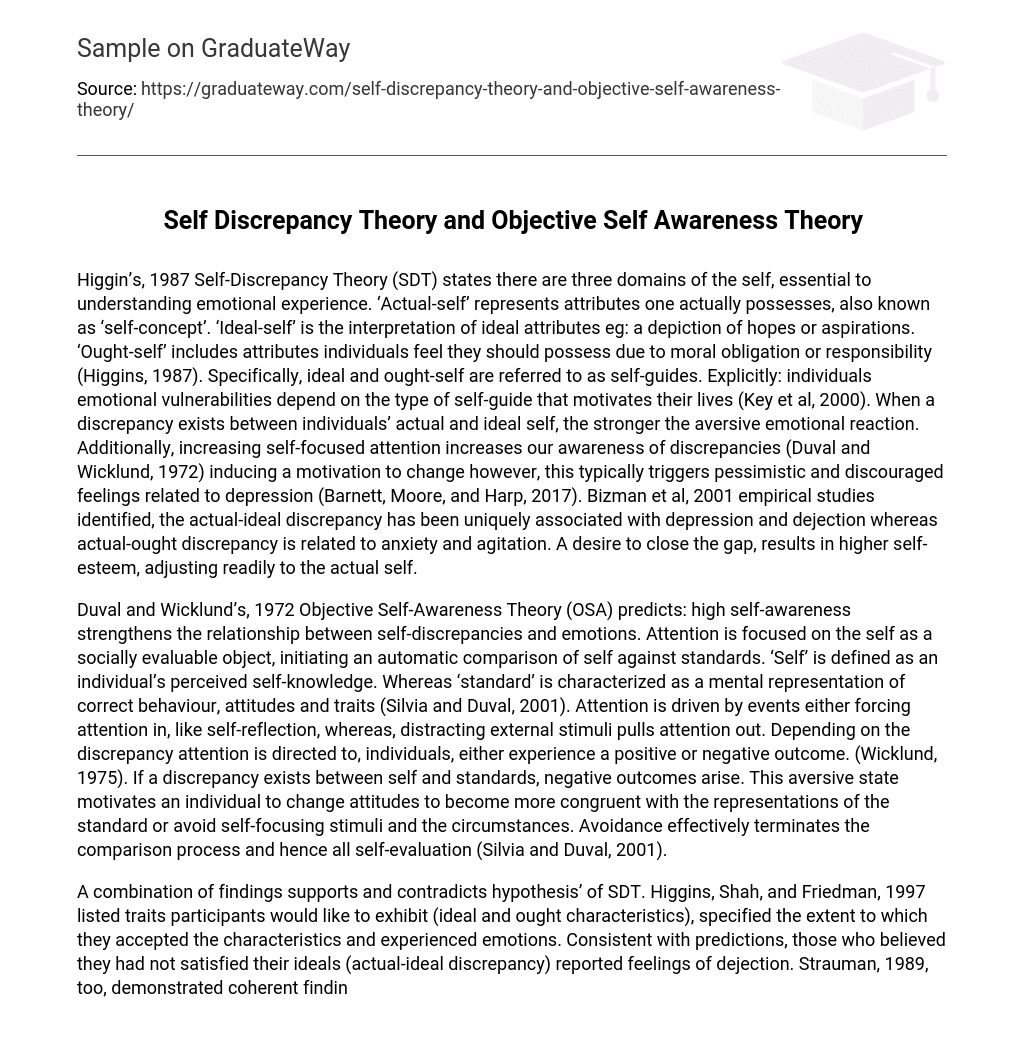Higgin’s, 1987 Self-Discrepancy Theory (SDT) states there are three domains of the self, essential to understanding emotional experience. ‘Actual-self’ represents attributes one actually possesses, also known as ‘self-concept’. ‘Ideal-self’ is the interpretation of ideal attributes eg: a depiction of hopes or aspirations. ‘Ought-self’ includes attributes individuals feel they should possess due to moral obligation or responsibility (Higgins, 1987). Specifically, ideal and ought-self are referred to as self-guides. Explicitly: individuals emotional vulnerabilities depend on the type of self-guide that motivates their lives (Key et al, 2000). When a discrepancy exists between individuals’ actual and ideal self, the stronger the aversive emotional reaction. Additionally, increasing self-focused attention increases our awareness of discrepancies (Duval and Wicklund, 1972) inducing a motivation to change however, this typically triggers pessimistic and discouraged feelings related to depression (Barnett, Moore, and Harp, 2017). Bizman et al, 2001 empirical studies identified, the actual-ideal discrepancy has been uniquely associated with depression and dejection whereas actual-ought discrepancy is related to anxiety and agitation. A desire to close the gap, results in higher self-esteem, adjusting readily to the actual self.
Duval and Wicklund’s, 1972 Objective Self-Awareness Theory (OSA) predicts: high self-awareness strengthens the relationship between self-discrepancies and emotions. Attention is focused on the self as a socially evaluable object, initiating an automatic comparison of self against standards. ‘Self’ is defined as an individual’s perceived self-knowledge. Whereas ‘standard’ is characterized as a mental representation of correct behaviour, attitudes and traits (Silvia and Duval, 2001). Attention is driven by events either forcing attention in, like self-reflection, whereas, distracting external stimuli pulls attention out. Depending on the discrepancy attention is directed to, individuals, either experience a positive or negative outcome. (Wicklund, 1975). If a discrepancy exists between self and standards, negative outcomes arise. This aversive state motivates an individual to change attitudes to become more congruent with the representations of the standard or avoid self-focusing stimuli and the circumstances. Avoidance effectively terminates the comparison process and hence all self-evaluation (Silvia and Duval, 2001).
A combination of findings supports and contradicts hypothesis’ of SDT. Higgins, Shah, and Friedman, 1997 listed traits participants would like to exhibit (ideal and ought characteristics), specified the extent to which they accepted the characteristics and experienced emotions. Consistent with predictions, those who believed they had not satisfied their ideals (actual-ideal discrepancy) reported feelings of dejection. Strauman, 1989, too, demonstrated coherent findings with samples of social phobic and depressives who experienced a similar discrepancy and emotional response. Conversely, those with ought dissatisfaction, reported feelings of agitation. Philips and Silvia, 2010 demonstrated, when methods were instituted to manage limitations, SDT is only partially supported. Specifically, actual-ideal discrepancies, predict depression alongside discrepancies between ought and actual too. This indicates, further immediate shortfalls can also induce depressive symptoms. Moreover, Tangney et al, 1998 demonstrated, depression was related to both actual-ought and actual-ideal discrepancies, challenging the theory and raising discriminant validity concerns. In previous studies, small sample sizes were used, implying associations between discrepancies and emotions could have been disguised. Silvia and Philips, 2010 used a larger sample allowing greater differentiation and increased validity. Additionally, only The Selves Questionnaire (Scott and O’Hara, 1993) was administrated to measure discrepancies originally. Difficulties determining what constituted a match, mismatch and nonmatch lead to subjective decisions; a limitation involving validity and bias (Key et al, 2000). Several scales would have control this, improving accuracy and consistency.
Support alongside contradictory findings were found regarding OSA theory. Silvia and Philips, 2013 demonstrated that comparing self to standards occurs automatically disregarding the term ‘awareness’. Automatic comparison seems intuitively plausible, however there is no direct evidence from the dynamics of self-evaluation assumed by the theory. Attention to self, initiates a comparison of self against standards and can operate without conscious reminders of the self. Furthermore, there is no solid evidence and direct tests of automatic self-evaluation. McConnell et al, 2009, highlighted individual differences have not been considered appropriately. Some individuals are more inclined to resolve self-discrepancies than others, especially those with high self-complexity to consider emotions. Those who exhibited low self-complexity, were more contingent upon emotions, compared to high self-complexity, who were less sensitive to self-discrepancies and corresponding emotions, implying lack of generalisability. Specific traits differ among individuals meaning individuals cope differently with a self-standard discrepancy, weakening external validity. Additionally, underlying cognitive representations such as self-belief systems and self-evaluative processes such as emotional-motivational states are complex. OSA theory lacks detail clarifying this aspect (Higgins, 1989). Wegner, 1994 theory of mental control provides a better explanation; self-awareness is considered a monitoring process in the mental system. Forthcoming research should broaden the links between self-evaluation and dynamics involved in cognitive aspects concerning OSA (Silvia and Philips, 2001). Furthermore, the theory lacks clarity how specific standards are selected from comparison processes and ways of dealing with a discrepancy. Carver, Blaney and Scheier, 1979 suggested people tried to reduce discrepancy or avoid progression to close the gap. Duval et al, 1990 suggested two factors are involved in coping with discrepancies; whether people felt they could effectively reduce the discrepancy and the scope. Those who believed a discrepancy to be mild with constant progress did not give up, however those who perceived remote progress, avoided. Nevertheless, only two coping mechanisms have been discussed therefore further examination is required as the theory seems limited especially as cognitive dynamics and mental representations regarding the theory has not been reviewed yet.
Although extensive studies exist backing both theories, if research support for implications mentioned in both SDT and OSA theory are found, then theories would have the potential of providing a unified model for addressing central issues that fall on the interface of social psychology. An interesting direction for future studies would be to take a fine-grained view concerning the cognitive aspects individuals adopt in complex social situations. Additionally, distinguishing between different types of coping mechanisms, self-belief patterns and demonstrating the activation process of aspects such as emotional-motivational states that automatically occur. Providing additional and extensive findings could potentially seal unexplained disparities within the current literature.





